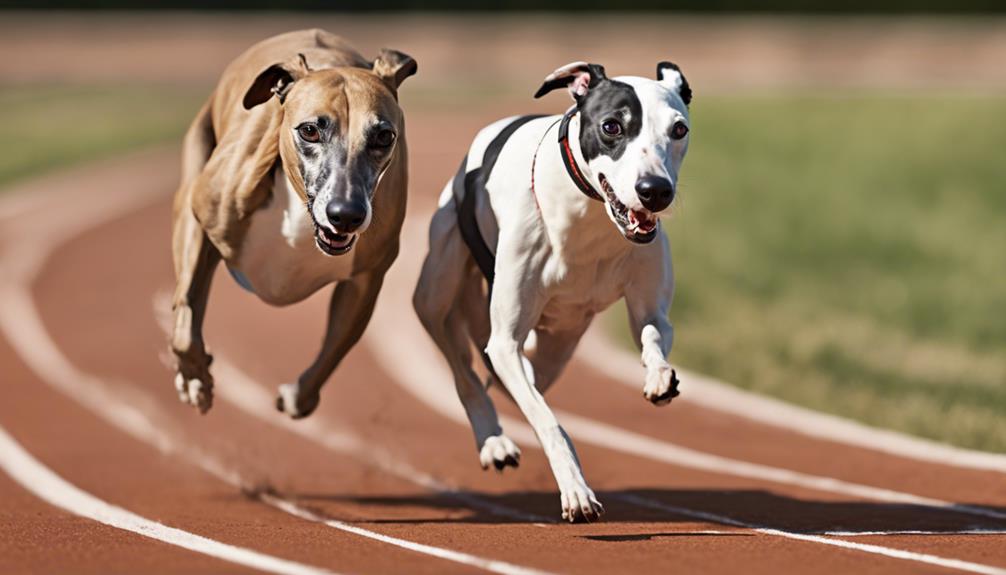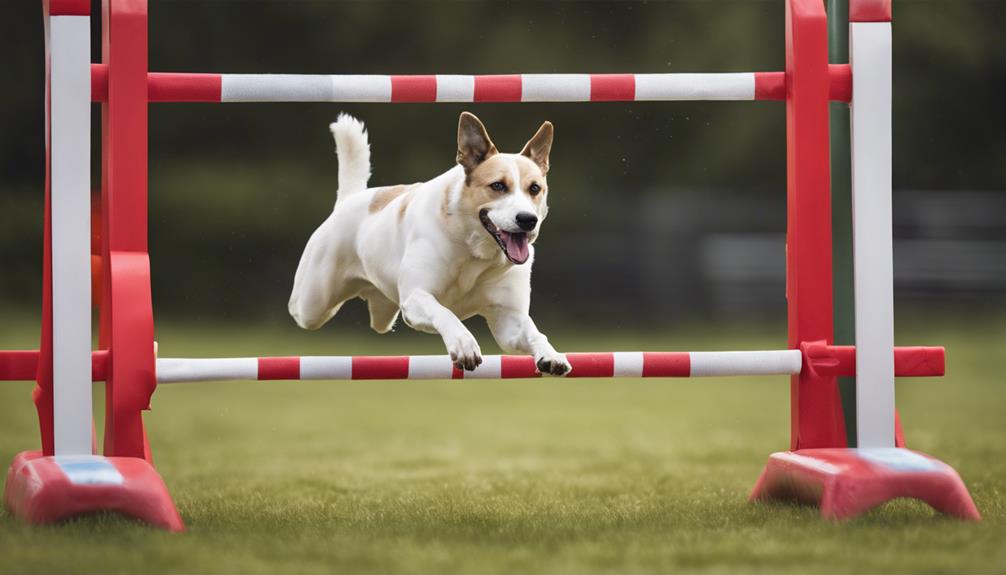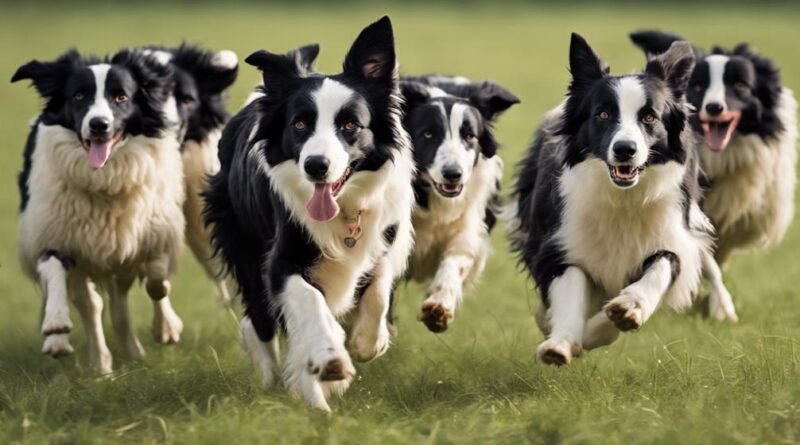Why Do Certain Breeds Excel in Specific Dog Sports?
Have you ever pondered why certain dog breeds seem tailor-made for specific sports?
There's a fascinating interplay between a breed's genetic makeup and its performance in athletic endeavors.
From the agility of Border Collies to the speed of Greyhounds, each breed brings a unique set of traits to the competition arena.
But what exactly lies at the core of their prowess in these sports?
Stay tuned to uncover the secrets behind why some breeds shine brighter in particular canine athletic pursuits.
Genetic Factors in Dog Sports

When considering genetic factors in dog sports, breed selection plays a crucial role in determining performance capabilities. Breed diversity is a key factor to consider when choosing a dog for a specific sport. Different breeds have been selectively bred over generations for various purposes, resulting in unique physical and behavioral traits that give them an advantage in certain activities. Understanding the inherent tendencies and abilities of specific breeds can greatly impact their success in dog sports.
Performance potential varies greatly among different breeds. Some breeds are naturally inclined towards certain activities, excelling in sports like agility, obedience, herding, or tracking. For example, Border Collies are known for their exceptional agility and intelligence, making them top contenders in agility competitions. On the other hand, breeds like Labrador Retrievers are renowned for their retrieving abilities, making them excellent choices for sports like dock diving or flyball.
Physical Attributes and Performance
Considering the genetic factors discussed in relation to dog sports, the physical attributes of specific breeds greatly influence their performance capabilities. When it comes to excelling in various dog sports, certain physical traits play a crucial role in determining a breed's success. Here's how physical attributes impact performance:
- Canine agility: Breeds with a lean build, flexible bodies, and good balance are often well-suited for sports that require agility, such as agility trials. Dogs like Border Collies, Australian Shepherds, and Shetland Sheepdogs excel in navigating obstacle courses due to their agility and nimbleness.
- Speed and endurance: Breeds that possess high levels of speed and endurance are ideal for sports like flyball or lure coursing. Dogs such as Greyhounds, Whippets, and Border Collies are known for their exceptional speed and stamina, allowing them to perform well in activities that demand sustained energy output.
- Muscle structure and physique: The muscular build and overall physique of a dog can determine its performance in sports like weight pulling or dock diving. Breeds like American Staffordshire Terriers, Rottweilers, and Labrador Retrievers, with strong muscles and well-proportioned bodies, often excel in events that require strength and power.
Instinctual Predispositions for Sports
Instinctual predispositions greatly influence a dog's aptitude and success in specific sports. Different breeds have inherent traits that make them more inclined towards certain activities. Understanding these predispositions can help in tailoring training techniques to enhance performance. Breed-specific training techniques play a crucial role in maximizing a dog's potential in sports.
For example, Border Collies have a strong herding instinct due to their history of working with livestock. This instinctual drive makes them excel in sports like agility and obedience trials that require quick thinking and sharp responsiveness. By incorporating activities that mimic herding behaviors into their training, you can harness this natural impulse to boost their performance in competitive settings.
On the other hand, breeds like Labrador Retrievers have a strong retrieval instinct. This innate drive makes them perfect candidates for sports like dock diving and field trials. Their love for fetching can be leveraged through specialized training techniques that focus on retrieving tasks, enhancing their skills and enjoyment in such competitions.
Breeds Bred for Specific Tasks
Breed selection plays a critical role in determining a dog's suitability for specific tasks and activities. Different breeds have been selectively bred over generations to excel in various roles, whether as working dogs or for their sporting abilities.
Breeds Bred for Specific Tasks
- Working Breeds: Certain breeds have been specifically developed for tasks such as herding, guarding, or pulling sleds. For example, the Border Collie is known for its herding instincts, while the German Shepherd excels in protection work and police tasks. These breeds have the physical and mental traits required for these specific jobs.
- Sporting Abilities: Many breeds are bred for their exceptional sporting abilities, whether it's agility, obedience, or retrieving. Breeds like the Labrador Retriever are well-suited for activities like retrieving in water due to their love for swimming and strong retrieving instincts. Similarly, the Border Collie's high energy levels and intelligence make them excellent competitors in dog sports like agility and obedience trials.
- Task-Specific Traits: Breeds bred for specific tasks often exhibit traits that are highly desirable for those tasks. For instance, the Siberian Husky's endurance and thick double coat make them ideal for pulling sleds in cold climates. These task-specific traits are a result of generations of selective breeding to enhance certain characteristics.
Breed Temperament and Training
Understanding your dog's temperament and how to train it effectively are essential aspects of responsible pet ownership. Each breed has unique characteristics that influence their behavior and training needs. When it comes to temperament training, it's crucial to consider breed behavior to tailor your approach.
Different dog breeds have been developed for specific tasks, which has also shaped their temperament. For example, herding breeds like Border Collies may have a strong instinct to chase and control movement, requiring training methods that engage their minds and bodies. On the other hand, breeds like Labrador Retrievers, known for their friendly and outgoing nature, may respond well to positive reinforcement training techniques due to their eagerness to please.
Breed behavior plays a significant role in determining the most effective training methods. Working with your dog's natural instincts and tendencies can make the training process more successful and enjoyable for both of you. Understanding your dog's breed characteristics can help you anticipate challenges and adjust your training approach accordingly.
Canine Athlete Conditioning Needs
Tailoring your dog's training regimen to meet their specific conditioning needs as a canine athlete is crucial for maximizing performance and preventing injuries. Understanding the nutritional requirements and exercise routines necessary for your dog's sport can make a significant difference in their overall athletic ability and well-being.
Here are three key points to consider when addressing your canine athlete's conditioning needs:
- Nutritional Requirements: Providing your dog with a balanced diet that includes the right mix of proteins, fats, and carbohydrates is essential for fueling their performance. Consult with a veterinarian or canine nutritionist to create a diet plan tailored to your dog's specific sport, size, and energy requirements.
- Exercise Routines: Designing a structured exercise routine that targets the muscle groups needed for your dog's sport is vital. Incorporate activities like agility drills, strength training, and cardiovascular workouts to enhance their endurance, speed, and overall athleticism. Remember to gradually increase the intensity of their workouts to prevent injuries and build stamina.
- Recovery Strategies: Implementing proper recovery strategies such as rest days, massages, and stretching exercises is key to ensuring your dog's muscles stay healthy and flexible. Adequate rest allows their bodies to repair and grow stronger, reducing the risk of overuse injuries and fatigue.
Crossbreeds in Competitive Sports

To excel in competitive sports, crossbreeds bring a unique blend of traits and abilities that set them apart from purebred counterparts. Mixed breeds often showcase exceptional agility in competitions, demonstrating a versatility that combines the best of different breeds. In agility competitions, their diverse genetic makeup can result in dogs that excel at navigating intricate courses with speed and precision.
Hybrid dogs, a product of intentional crossbreeding, have been increasingly successful in obedience trials. Their mixed heritage can lead to a combination of intelligence, trainability, and a strong desire to please, making them quick learners and excellent performers in obedience sports. This adaptability allows them to thrive in various obedience exercises, showcasing their ability to follow commands accurately and exhibit impressive levels of focus and responsiveness.
Crossbreeds also tend to have fewer genetic health issues compared to some purebred dogs, which can enhance their longevity and overall performance in competitive sports. Additionally, their unique appearance and personalities often make them popular contenders in events that require interaction with judges or audiences.
The Future of Canine Sports
The evolution of canine sports continues to shape the future landscape of competitive events for dogs worldwide. As the world of dog sports progresses, several key trends are emerging:
- Evolving Competitions: Canine sports are constantly adapting to meet the changing needs and interests of participants. New formats, such as team-based competitions or combined events, are being introduced to keep the sports fresh and engaging for both competitors and spectators. Additionally, traditional sports like agility or obedience trials are incorporating elements from other disciplines to create more dynamic and challenging experiences for dogs and handlers alike.
- Technological Advancements: The future of canine sports is closely intertwined with technological innovations. From advanced tracking systems that provide real-time performance data to virtual reality simulations for training purposes, technology is revolutionizing how dogs prepare for and compete in sports. Wearable devices for dogs, such as fitness trackers or health monitors, are becoming increasingly common, allowing handlers to monitor their furry athletes' well-being more closely and optimize their training regimens.
- Global Accessibility: With the rise of online platforms and streaming services, canine sports are becoming more accessible to a global audience. This increased visibility isn't only broadening the reach of these sports but also fostering a sense of community among dog enthusiasts worldwide. As participation in canine sports transcends geographical boundaries, the future promises a more diverse and inclusive landscape for dogs of all breeds and backgrounds to showcase their skills and athleticism.
Frequently Asked Questions
How Do Different Training Methods Impact a Dog's Success in Specific Sports?
When it comes to how different training methods impact a dog's success in specific sports, positive reinforcement and clicker training can make a big difference.
By using positive reinforcement techniques like treats and praise, you can motivate your pup to excel in their sport.
Clicker training helps to create clear communication between you and your dog, making it easier for them to understand what's expected of them during training sessions.
Are There Any Sports Where Mixed Breed Dogs Outperform Purebred Dogs?
In some sports, mixed breed dogs can outperform purebreds due to their unique advantages. This showcases the benefits of breed diversity in sports.
Mixed breeds often combine various qualities that can give them an edge, while purebreds may have limitations based on their specific breed characteristics.
It's interesting to see how different backgrounds can influence performance in various dog sports, highlighting the importance of individual strengths and abilities.
What Role Does the Handler's Experience and Skill Play in a Dog's Performance in Sports?
When it comes to a dog's performance in sports, the handler's influence is crucial. Your experience and performance skills can make a big difference in how well your dog does.
Your ability to train, communicate, and guide your furry friend can impact their success in competitions. With practice and dedication, you can enhance your dog's performance and achieve great results together in various sports.
Can Older Dogs Still Excel in Competitive Sports, or Is It Mainly a Young Dog's Game?
Yes, older dogs can still excel in competitive sports! Senior athletes bring a wealth of experience and dedication to the game. With age comes refined technique and a deep understanding of the sport.
While young dogs may have energy on their side, the wisdom and skill that older dogs possess can give them a competitive edge.
How Do Environmental Factors, Such as Climate and Terrain, Affect a Dog's Performance in Sports?
In dog sports, environmental factors like terrain challenges and climate variations can significantly impact your furry athlete's performance. The terrain your dog navigates during training or competitions can pose unique obstacles that may influence their abilities.
Likewise, different climates can affect your dog's endurance and overall performance. Remember, genetic influences also play a role in how well your dog copes with these environmental challenges, shaping their success in various sports.
Conclusion
So, next time you see a Border Collie excelling in agility or a Labrador Retriever dominating in dock diving, remember that it's not just luck or training. These breeds are genetically predisposed to excel in these specific sports due to their physical attributes, instincts, and temperament.
Understanding these factors can help you appreciate the unique talents and abilities that different breeds bring to the world of canine sports. Keep cheering on your favorite furry athletes!
